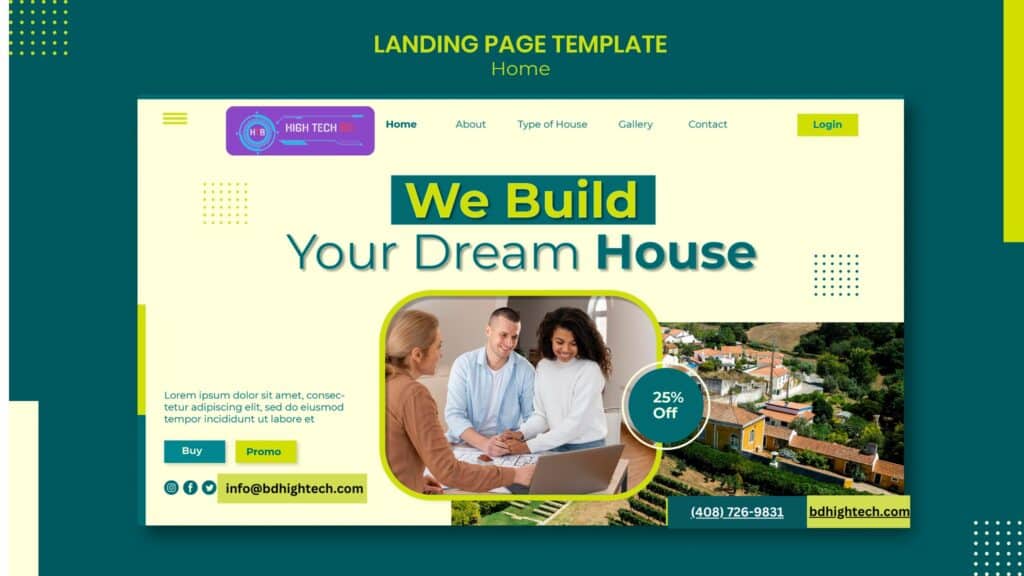Best-Looking Custom Homebuilder Websites
Best-Looking Custom Homebuilder Websites serve as a digital gateway to showcase craftsmanship, build credibility, and attract potential clients. In an increasingly competitive market, having an attractive and SEO-friendly website isn’t just optional—it’s essential. These websites combine cutting-edge design, engaging user experience, and robust functionality to highlight a builder’s expertise and creativity.
If you’re a custom homebuilder or planning to create a website for one, here’s a detailed guide on what makes the best-looking homebuilder websites stand out and how they can boost your online visibility

Striking Visual Best-Looking Custom Homebuilder Websites
The best homebuilder websites are visually stunning, capturing attention within seconds. High-quality visuals of completed projects, such as panoramic views of homes, interiors, and exteriors, are crucial. A visually engaging homepage can leave a lasting impression.
- Key Features:
- Full-width hero banners with call-to-action (CTA) buttons.
- Sleek, clean design layouts with consistent fonts and color schemes.
- High-resolution project galleries with dynamic sliders.
2. Best-Looking Custom Homebuilder Websites User-Friendly Navigation
A clutter-free, intuitive navigation system ensures visitors can easily find information about services, projects, and contact details. When users can effortlessly explore your site, they are more likely to stay longer, boosting engagement and lowering bounce rates.
- Key Components of Navigation:
- A well-structured menu bar with links to essential pages (About Us, Portfolio, Services, Blog, Contact).
- Sticky navigation for easy scrolling.
- Mobile-first design to ensure accessibility across all devices.
3. Showcasing Portfolio Effectively
Potential clients want to see what you’re capable of building. A dedicated “Portfolio” or “Projects” page with detailed descriptions of completed homes is essential.
- Optimization Tips for the Portfolio:
- Use SEO-friendly titles like “Luxury Modern Homes Built in [Location]”.
- Add alt text to every image to improve search engine visibility.
- Include client testimonials for credibility.
Interactive features like 3D virtual tours, project timelines, and before-and-after visuals can elevate the portfolio section.
4. SEO-Optimized Best-Looking Custom Homebuilder Websites Content
Content plays a pivotal role in driving organic traffic to your website. The best homebuilder websites include keyword-rich content tailored to the target audience’s needs and search queries.
- Content Ideas:
- Blog posts on topics like “5 Design Trends for Custom Homes in [Year]” or “How to Choose the Right Custom Homebuilder.”
- FAQs about the homebuilding process to address common client concerns.
- Case studies detailing challenges and successes of specific projects.
Ensure all content is optimized with headers, meta tags, and strategically placed keywords like “custom homebuilder,” “luxury homes,” and “modern home design.”
5. Fast Loading Speed
No matter how visually appealing your site is, a slow website can drive visitors away. Optimizing loading speeds is crucial for user satisfaction and better rankings in search engine results.
- Ways to Improve Speed:
- Compress large images without compromising quality.
- Use a reliable hosting service.
- Minimize the use of heavy plugins and scripts.
Google PageSpeed Insights can help you identify areas for improvement to ensure optimal performance.
6. Responsive and Mobile-Friendly Design
With most users browsing on their smartphones, a responsive design is non-negotiable. Custom homebuilder websites must look and function perfectly on devices of all sizes.
- Essential Mobile-Friendly Features:
- Tap-friendly buttons and menus.
- Simplified layouts for smaller screens.
- Fast-loading images optimized for mobile viewing.
7. Interactive Elements
Interactive features add a modern touch and engage visitors. These elements can make your website memorable while showcasing your technical expertise.
- Ideas for Interactive Features:
- Cost calculators to estimate building expenses.
- Interactive maps showing locations of past projects.
- Appointment scheduling tools integrated into the site.
8. Incorporating Testimonials and Reviews
Client testimonials build trust and social proof, showing potential customers that others have had positive experiences.
- Best Practices for Displaying Reviews:
- Feature testimonials on the homepage or a dedicated “Testimonials” page.
- Use video testimonials for a personal touch.
- Highlight awards and recognitions from reputable organizations.
9. Local SEO Strategies
Custom homebuilders typically serve specific geographic areas, making local SEO critical. Optimizing for local search ensures that potential clients nearby can find your services easily.
- Key Local SEO Strategies:
- Add location-specific keywords like “custom homebuilder in [City, State]”.
- Create a Google Business Profile and embed Google Maps on your site.
- Encourage satisfied clients to leave reviews on platforms like Yelp or Google.
10. Secure and Accessible
A secure website with HTTPS certification reassures visitors that their information is safe. Accessibility features, such as alt text for images and keyboard-friendly navigation, ensure your site is usable for everyone.



